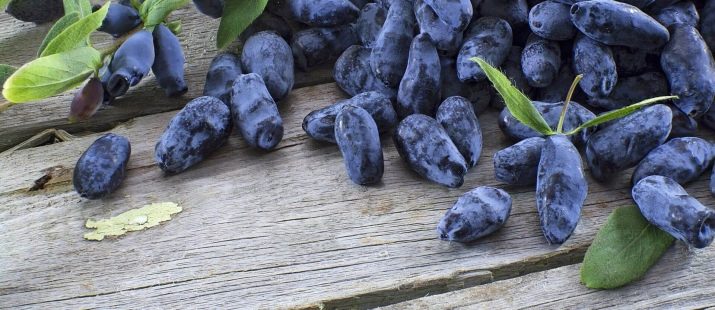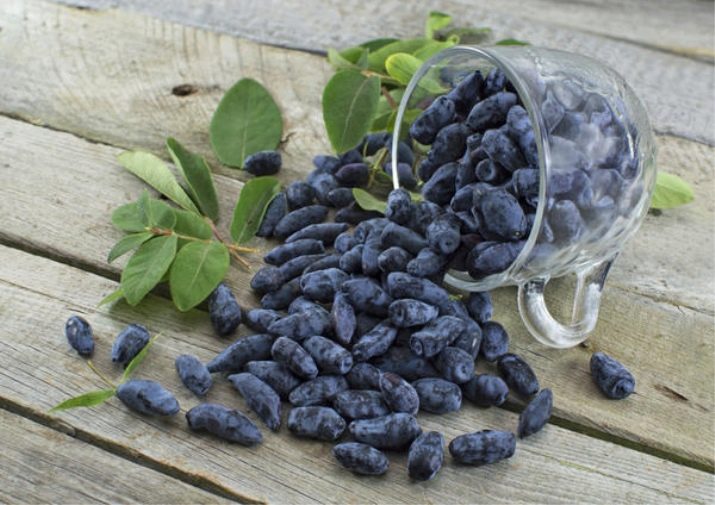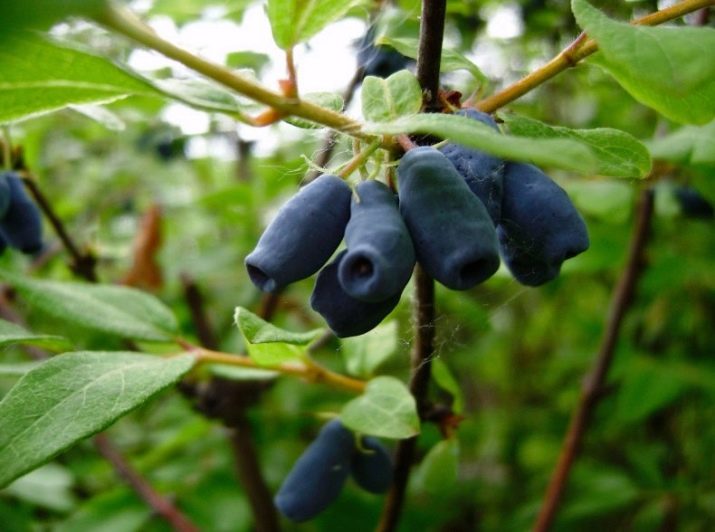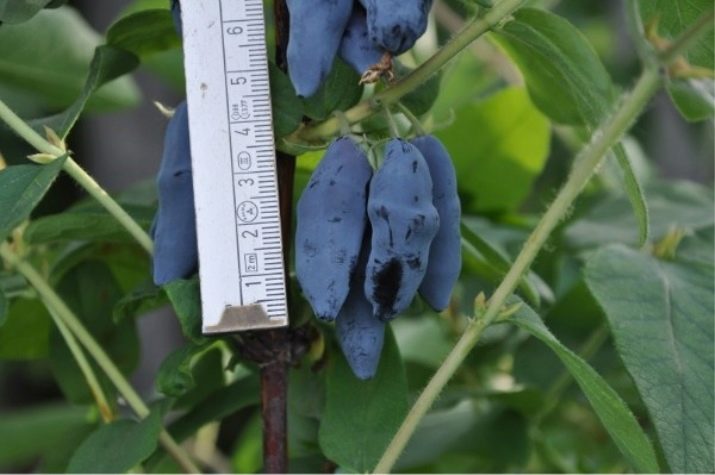Honeysuckle: description of the plant and variety of varieties
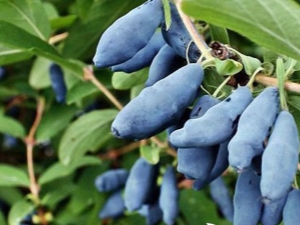
In total there are about 200 species of honeysuckle, about 50 of which grow in Russia.Gardeners and gardeners are increasingly choosing this shrub for growing on their site, and there are grounds for this. In addition to a good harvest of useful berries in the middle of summer, the plant will delight you with its unusual appearance all season. This shrub will add to any garden new colors and wonderful fragrance during the flowering period.
Plant description
Honeysuckle - a family of shrubs and trees of the genus Varsyankotsvetnye. The height of this plant in the adult form varies from 0.5 to 3 m. The branches of the bush cover the leaves of an oblong form, on the outside they have a more greenish tint, and inside are much paler. In May, when not all the foliage of the plant has dissolved, the honeysuckle begins to bloom. Flowers in the inflorescence can be different shades from blue to purple. Due to the bright aroma that attracts bees, the process of pollination occurs.
Frost resistance and ease of care distinguish this variety from other crops. Three years after planting, the first berries can be expected. In one summer, the plant can produce from 2 to 4 kg of crop. On any site such a plant, fragrant in spring and covered with berries in summer, will be a real decoration.
Fruits cover the skin of a bluish tinge with a slight touch, the length of the berry, depending on the variety, can reach a size of from 1 to 5 cm. Berry pulp has excellent sweet taste, which complements the light sour taste. Vitamins and other beneficial substances are contained in the berries, they contribute to the prevention of many diseases.
From honeysuckle you can make jam, jam, compote, juice and even wine. In their composition no more than 9% sugar. Calorie honeysuckle is 35 kcal per 100 g
In March or November it is recommended to plant honeysuckle in the ground. In one place should be planted at least 2 species, because the plant needs pollination. Sunny land with fertile land is an ideal place for growing shrubs. Plant honeysuckle should be, respecting the interval of 1.5 m. Cutting the dry branches of this culture - the easiest and most necessary way to care for shrubs.
The berries are covered with a very thin shell, and also easily crumbling from the branches to the ground - these are the two main minuses of this plant. To avoid damage to the fruits when they fall, you can take the following measures: you should stretch the fabric under the bush, where the berries will fall off. However, very soon this deficiency will be completely eliminated, since scientists are already working on creating a new species with a stronger skin.
Variety of varieties
Every year the popularity of honeysuckle only increases. Nowadays, you can find a lot of varieties and species of this shrub. An interesting specimen is best purchased in the nursery.
The main indicator of the variety is its taste characteristics. Taste shades of honeysuckle fruit are different: sweetish, sour, with bitterness. The names of the species often reflect some of their characteristic or indicate the origin.
To create new varieties, scientists use existing species of this plant, which helps to produce viable samples that meet the main requirements of gardeners. The most important characteristics include the following items:
- large amount of harvest;
- minimum honeysuckle fall;
- the size;
- resistance to adverse conditions and diseases;
- terms of fruiting.
The following is a detailed description of the varieties of honeysuckle, which are among the most popular among beginners and experienced gardeners.
"Blue Spindle"
Berries of this species ripen early enough. The shrub has a rare crown and branchy, strong and powerful shoots. In height, the plant does not reach more than a meter. Dark green foliage dotted with branches of a plant.
The mass of one berry is 1.4 g, and the length is 3 cm. The honeysuckle has an oblong shape, flat from below and sharper from above.Inside the berries are juicy and soft, sweet to the taste, with a slight sour taste.
"Blue spindle" tolerates winter, does not need special care. One plant per season can bring about 2.5 kg of crop to owners.
"Blue bird"
Kamchatka honeysuckle became the ancestor of this type of shrub. It is a pleasure to grow Blue Bird, because the variety is not prone to the spread of diseases and harmful insects, and also pleases owners with good yields.
Three years after planting, the first fruits ripen on the branches of the shrub. The bush possesses strong escapes and an oval crown, perfectly grows and develops.
Blue-blue honeysuckle is covered with oily bloom. The taste of the fruit is pleasant, without sourness. The weight of one berry is 130 g. During the summer, from one to three bushes from 1.5 to 3 kg of berries ripen on one bush.
"Bakchar anniversary"
Variety Bakchar selection. Shrub strong-growing, dense, with a spherical crown. Fruits are covered with a bluish-blue shell, with a waxy coating. Berries oblong, teardrop-shaped. The weight of one berry is -0.79 g, the fruits are most often of medium size, their surface is covered with tubercles.
Under the dense skin is hidden tasty flesh, sweet and sour in taste, with a slight bitterness. Berries varieties "Jubilee" have a faint flavor.
Honeysuckle ripening occurs in the first two weeks of July. You can collect the fruits manually or mechanically. Sapability is small. During the season, one plant can give its owners 1.5-3.8 kg of crop.
"Brown" ("Lonicera Brownii")
This variety is a fast-growing liana shrubs, reaching 5 meters in height. Its leaves are elliptical in shape. On top of the plate is a bright green color, and on the bottom is blue-blue. At the ends of the shoots a pair of young leaves grows together in 2 solid discs.
Flowering "Lonicera Brownii" plentiful and beautiful. Flower petals have a carrot-red color, they appear in June-July and continue to delight everyone around with their beauty for about 3 weeks. Secondary blooms also occur in August-September.
Variety tolerates winter frost, but can freeze slightly, but the bush is very quickly restored. For the cultivation of this species are suitable areas that are well lit by the sun, closed from the wind, draft.
"Leningrad giant"
This variety of honeysuckle belongs to early ripe species. The plant grows quickly and reaches a height of 1.5 meters.
The fruits of this type are fragrant, sweet-sour to taste. The Leningrad Giant is well going through the cold winter months and is not subject to the spread of diseases, viruses, and pests.
Silginka
Variety refers to the medium early varieties. Berries are sweet, with a slight sourness. The shrub looks decorative, has powerful branches, which are decorated with many leaves of rich green color. The height of the plant is not more than 1.5 m.
Spread rounded crown covered with fruits. The mass of one berry is about 1.4 g. Honeysuckle is oval in shape with a pointed top. Color of a skin - dark blue, is a wax raid. In one season, the shrub can give its owners about 3 kg of berries.
"Silginka" is perfectly experiencing heat and low temperature, and gardener's reviews confirm that the plant is also not afraid of diseases and harmful insects. Fruits remain on the branches for a long time, they do not sypyats and can wait a long time for collection.
"Kamchadalka"
Inflorescence "Kamchadalki" - a pair of yellow flowers. The shell of the fruit is blue-blue. The honeysuckle is rather large in size, 1 cm in diameter, 2.7 cm in length. The honeysuckle fruits of this species are oval, long, pointed at the end, weighing about 1 g. The berries are covered with a smooth skin with a slight patina that hides the fibrous, juicy flesh.
"Kamchadalka" has a sweet-sour taste and a pleasant aftertaste. In one season, the plant will bring owners from 1.2 to 1.8 kg of mature yield. Representatives of the species ripen in average terms, so it’s not worth waiting for the fruits at the beginning of the season.
The view tolerates low temperature and drought. The variety can be grown in areas with a temperate climate. Honeysuckle should be planted in areas well lit by the sun.
"Delight"
Variety Bakhchsarai breeding. Srednerosly plant has straight shoots, the height of the bush can reach 180 cm, as well as width. The mass of one berry is 1.6 g. The honeysuckle covers the wax coating, the color of the shell is blue-violet, the length is about 5 cm.
The fruit is sweet and sour. The skin is strong and firm, so the berries can be transported freely. Ripening of berries occurs almost simultaneously, the fruits can be frozen and stored in the freezer or consumed fresh. Gather berries of this type mechanically or manually. The berries on the branches are very convenient, making it easy to pick them. Honeysuckle "Delight" is characterized by medium shedding. With one bush for the season, owners can collect from 2.6 to 5.6 kg.
Volkhov
The species was first bred by Leningrad scientists. Tall and thick branches of a bush form an oval crown, covered with foliage. Fruits are long, oval, with a pointed edge upwards, covered with a thin, soft and slightly bulky skin of a blue-blue shade.
The weight of one berry - 1 gram, length - 22 mm. The taste of the fruit is sour-sweet, with a rich smell. This variety matures at the end of June. Harvest can be mechanically, because the berries are almost not showered.
During the summer one bush can bring 2.2-3.5 kg of ripe fruit to the owners. To obtain a rich harvest, it is recommended to plant several different types of honeysuckle close to each other to ensure pollination of plants.
"Daughter of the Giant"
This species was obtained by breeders by crossing wild species growing in the Far East. The “Daughter of the Giant” has excellent yields and large fruits. The mass of one berry is 2.5 g, and the length is about 3.6 cm.
During the season the plant brings 5.6 kg of ripe harvest. Honeysuckle on the branches held tightly, does not fall off, which greatly facilitates the process of collecting. The variety is characterized by a medium term ripening.
In April, the first inflorescences appear on the branches of the plant, and in the first half of July it is already possible to pick ripe berries. The taste of the berries are sweet, covered with purple-blue sandpaper. Berries differ from other varieties of pear-shaped form. The shrub is never more than 1.8 m, the shoots form an oval crown.
3-4 years after planting, it will be possible to collect the first fruits. The Daughter of the Giant perfectly tolerates the winter cold and does not require special care.
The plant needs the soil in the area where it grows to be constantly wet, in arid regions it is necessary to conduct daily watering.
Malvina
Malvina is a high-yielding variety of honeysuckle. The plant is usually medium size, strong branches form its crown. Shoots covered with dark green foliage. Berries elongated pear shape. The taste of Malvina honeysuckle is sweet and sour, the berries are covered with a thick blue skin, weight - 1.2 g.
During the summer from a bush you can collect from 1.6-2.9 kg of ripe berries. "Malvina" perfectly tolerates frost. Fruits are best consumed fresh. Shrubs are often used as an element of garden design. It is recommended to thin out a plant in 1-2 years, and old shoots are completely removed in 7-10 years.
How to choose?
When choosing honeysuckle seedlings, one should pay attention to their age; two-year and three-year-olds are a priority for experienced gardeners. Buying such a shoot, you can prepare for harvesting next year.
Before buying, you should carefully examine the sapling. Its branches must be flexible, without damage. It should be remembered that this type of shrub can peel off the bark, but you should not be afraid of this, since this feature is characteristic of this culture.
It should also examine the roots. They must be powerful and massive.Should choose the seedlings with swollen buds on the branches.
It should also be remembered that honeysuckle will not bear fruit alone. At one site it is recommended to plant at least 2-3 different species. If you do not know paired pollinators, then you can simply take more seedlings of different varieties.
It should also be borne in mind that the fruits of honeysuckle, especially in the varieties of the first generation, fall off very quickly. This should be taken into account when choosing a variety, and if it is not possible to stay on the plot permanently in order to harvest a mature crop on time, then it is better to give preference to non-crumbled species.
Choosing a new variety, you should pay attention to checking its viability in the region where it is planned to plant. For example, in conditions of a middle band, a plant grown in another area may not settle down, since some varieties of honeysuckle tolerate “other people's places” very poorly.
What species need to plant together?
Honeysuckle flowers are bisexual, while needing cross-pollination, because they are self-infertile. The process of pollination occurs due to bees, bumblebees and wasps. Insects are carriers of pollen, so it is better if the flowers belong to various types of honeysuckle, because the number of species planted next to one site depends on the yield of plants.
Honeysuckle flowers are collected in paired inflorescences and bloom only for a day. Provided that insects pollinate even one bud in the inflorescence, two berries will ripen.
Before buying seedlings should pay attention to the characteristics of the species. Usually breeders indicate in the description which variety will suit this variety as a pollinator.
Planting the most popular varieties of honeysuckle is recommended, adhering to the following scheme.
- "Blue Spindle" is best planted in one area with cultures developed on the basis of Kamchatka varieties - "Cinderella", "Blue Bird", "Azure", "Kamchadalka". Pollinator can also be "Tomichka", "Memory of Gidzyuk."
- In order for the berries on the shrub of the Blue Bird variety to start, it is necessary to plant the Blue Spindle, Kamchadalka, Start, Cinderella, Morena, and Blue Tree nearby.
- To get a large amount of ripe berries “Bakcharskaya”, the following varieties are planted next to each other, providing cross-pollination. These are “Silginka”, “Strezhevchanka”, “Yugana”, “Daughter of the Giant”, “Bakcharsky Giant”.
- Next to the "Leningrad Giant" should be planted variety pollinator, so that the plant brought berries. Well suited for this role of “Morena”, “Malvina”.
- As the Silginka pollination, the Giant variety is best suited for neighbors.
- For Kamchadalki, Cinderella, Roxana, Blue Spindle, In Memory of Gidzyuk can become a pollinator on one site.
- The Daughter of the Giant, Silginka, and Yugana are suitable for the role of the pollinator for Delight.
- For the variety "Volkhov" you can use "Silginka", "Daughter of the giant", "Strezhevchanka", "Bakcharsky giant".
- For pollination of the “Daughter of the Giant” variety, “Delight” and “Bakchar Giant” should be planted nearby.
- Self-infertile "Malvina" needs cross-pollination. Therefore, the following types of culture should be planted on the site: "Blue Spindle", "Blue Bird", "In Memory of Kuminov", "Start".
Interesting Facts
- This culture is famous for its antipyretic and anti-infective action. Also, this plant is often used for poisoning and bleeding.
- Chinese sages have long used an infusion of dried flowers of honeysuckle in order to prolong their lives and gain strength.
- The aroma of honeysuckle flowers has a calming effect on the human nervous system, helps relieve stress.
- If you believe the old belief, the house next to which a honeysuckle bush is planted will always be filled with prosperity.
- Happiness and joyful mood will help to attract dried plant parts to a house, collected in a bag made of cloth.
- Eternal love is symbolized by honeysuckle in the legends of many nations of the world. Honeysuckle followers of ayurveda consider aphrodisiacs.
- The aroma of flowers of this plant is used to create perfume compositions by many well-known brands.
- Wolfberry is a type of honeysuckle.
- Fruits have a beneficial effect on the cardiovascular system, have a diuretic and choleretic effect.
- The roots of the plant are branched rather densely and are located close to the surface of the earth.
- Honeysuckle can easily grow in one place up to 20 years. One of the main advantages of this shrub is the ability to easily transfer to another place.
- A couple of years after planting the plant in the ground at the bush will begin to fall off the bark. It does not cost to be afraid, because it is one of the features of the plant.
- Only black and blue berries of honeysuckle can be eaten, red and orange fruits are poisonous.
- The phase of full fruiting in this crop begins after the first kilogram of berries collected from the bush.
- The best yield of honeysuckle is observed from 8 to 15 years of its life.
- 130 years - so much can honeysuckle grow and bear fruit in one place.
- This plant is often used for decorative purposes. Landscape designers use this shrub to decorate alpine slides, multi-level flower beds.
On why you need to plant honeysuckle, see below.





